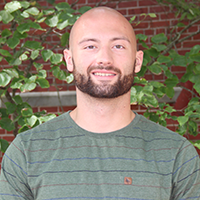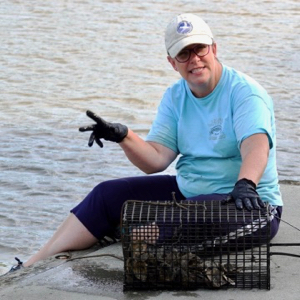Andrew Corso wears many hats. A doctoral candidate at William & Mary’s Virginia Institute of Marine Science, he recently conceived a social media idea — Faces of the Chesapeake — that combines several of his many interests and pursuits: fisheries research, recreational angling, photography and journalism.
Hashtagged as #FacesoftheChesapeake, the thread recently launched on VIMS’ social media channels and website through the joint efforts of Corso, fellow graduate students Miguel Montalvo and Savannah Mapes, and social media manager Laura Patrick.

“Some of my favorite social media pages are the ‘Humans of …”’ accounts, an idea pioneered by the famous Humans of New York,” says Corso. Begun as a photoblog in 2010, “HONY” now provides 20 million followers with daily glimpses into the lives of strangers on the streets of New York City through candid portraits and quotes.
Corso conceived his twist on the HONY idea while fishing at the Gloucester Point Fishing Pier, a short walk from VIMS’ main campus on the York River. A conversation with a local family of anglers revealed a shared passion for the bay and its marine life, sparking Corso’s interest in finding a way to strengthen connections among researchers and fellow residents.
“I figured something like HONY in our area might showcase the diverse users of the bay, many of whom are often overlooked in other forums,” says Corso. “I’ve also heard quite a few grad students say they’d value a greater connection with the broader Chesapeake Bay community. I think this connection is important for illustrating our interactions with the Bay community, engaging stakeholders with the importance of VIMS research, and showcasing the diversity of those who use and love the bay.”
As social media manager at VIMS, Patrick developed the #FacesoftheChesapeake hashtag and a visual frame to help viewers follow the series on the institute’s Facebook page, Instagram channel, and website.
“I like photos that help tell a person’s story and portray an individual’s humanity,” she says. “Through these posts, we aim to build connections and better know the community of people with whom we share the bay.”
VIMS posted its first #FacesoftheChesapeake entry in mid-March, featuring a photo and quote from “Darrel” (the posts use first names only to safeguard the participant’s privacy).
“I treated my interview with Darrel as kind of a proof-of-concept,” says Corso. “I met him at the Gloucester Point Fishing Pier — a place I feel comfortable because I fish there a lot myself — and asked him about his favorite memories and experiences on the bay.”
Darrel’s response shows he’s an angler with a heart as big as the lunkers he hopes to catch:
“My favorite fish story happened about two weeks ago. I was fishing at the Buckroe Pier just out of Hampton and caught my limit of puppy drum. I caught one extra, and I gave it to a guy who had just migrated up from Honduras. He didn’t speak much English, but he understood that I needed help with bringing the fish up. So he dropped a net, helped me catch the fish. So the last one I caught, I gave it to him.” – Darrel
Future faces
Anglers like Darrel are just one of the many different sorts of bay enthusiasts Corso and his colleagues plan to feature in future posts.
“We’d like to highlight a broad range of stakeholders,” Corso says. “These could include birdwatchers, boaters, watermen, coastal homeowners, oyster growers, beachgoers, nature photographers—the list could go on and on. We envision a lot of flexibility for what’s discussed in the text, but the focus will always be on the theme of bay usage.”

In the pipeline are posts from Kim, a tourist collecting shells and trash from the beach; George, an ex-Navy Seal who dives year-round in the bay; Taylor, a Marine Police officer with a story of a recent harrowing rescue; and Celeste, a co-founder of Mobjack Bay Coffee Roasters who organizes beach cleanups.
Corso also envisions that #FacesoftheChesapeake will ultimately expand beyond the current team to feature contributions from the entire VIMS community.
“I think the project will be the most sustainable and rewarding if it eventually becomes somewhat open-source,” he says. “After we get it up and running and set a tone, I’d hope that other students, staff, and faculty would feel comfortable submitting their own photos and interviews. This would provide a means to share and celebrate our many interactions with the community during field-research activities.”
Corso adds, “We might even learn some research priorities for future projects through consulting local knowledge.”
Community-science partnerships are of growing interest and practice nationwide. Local examples include VIMS’ Catch the King project, which leverages community science to collect flood data throughout coastal Virginia; a recent survey of Bay crabbers concerning derelict crab pots; the Virginia Game Fish Tagging Program; and a VIMS’ collaboration with the Northern Neck Master Gardner’s Shoreline Evaluation Program and a regional Living Shoreline collaborative.
Science and society

Corso’s conception of the #FacesoftheChesapeake project reflects an avid interest in the intersection between science and society — an interest he shares with Montalvo, Mapes and the entire VIMS community.
Corso earned his undergraduate degree in biology from William & Mary in 2016, with a thesis that focused on using principles of visual ecology to design a crab trap that minimizes by-catch of diamondback terrapins. For his Ph.D., he is studying the ecology and distribution of larval fishes in Antarctica, as part of VIMS’ involvement in the National Science Foundation’s Palmer Long-Term Ecological Research Program. He has shared his polar research with the public using a high-end camera donated by OceanX and The Explorers Club, and through a recent pair of articles in the Smithsonian Magazine and Imbibe.
